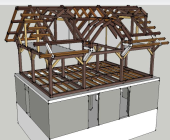I've been meaning to drop in on this thread ever since Juliet brought my attention to it. I'm the principal developer behind Practical Plants, and over there we're working hard on building a globally relevant plant use database.
The most important thing we learned is building a database like this is hard. Technologically it's easy... designing a database schema and thinking about what terms and properties you want to define in an abstract sense is both easy and fun. Once you start actually having to collect and build data, it gets difficult. It's hard to find reliable sources of data; it's super hard to merge that diverse data well; and it's harder still to build and maintain an active community to look after that data.
The difficulty in maintaining a community effort to build this kind of resource is one of the key points for me. The permaculture community is a passionate one, but it's not huge, and I don't believe it has the resources to maintain multiple databases without harming the effectiveness of each. Most of the work on Practical Plants is really being done by a very small number of committed individuals, with a large number of others making very occasional corrections. I'd urge any new database project with similar aims to Practical Plants to define how it might differ, and to open a dialogue with us - we're a totally open community, and very open to new ideas of what data we should define, how we should collect and share it, and so on!
We're really actively developing things further right now, and we've got some big changes in the pipeline. It's a great time to get involved and help steer and established database in new positive directions; then we all, as a community, are building a database we can use for any other projects we want to create... Right now we're working on:
- Moving to a server farm backed by major university funds, to guarantee we stay online without bills for the forseeable future
- Removing the Non-Commercial license restriction (the NC isn't as "nice" as it sounds, and can actually non profit organisations from using the data if they operate commercially in any way)
- Integrating new data sources from the biodiversity community for species distribution maps
- Importing established ontology terms to provide a more compatible API endpoint, and working on defining a plant use ontology for others to use (we haven't found an established one yet!)
- Integrating external data sources for plant pest information and plant interactions
- Experimenting with new methods of storing multi-factual data
- Data dumps in XML, CSV and JSON
- Improved API documentation
I would personally love to see Practical Plants working as a source of data powering applications which empower the permaculture community - applications which help people plan, design and maintain their eco systems. We're working on ways to export our data into a number of formats to power just this kind of thing. But it would make me really sad to see the data moved to a system which modified the data (sharing modifications between databases one they fork is SUPER hard), and we end up with two databases trying to achieve the same goal, dividing the community between them.
I think the most important thing in a community of this size is that we're all talking. There's not many people here with both the time and capability to build something like this, so our resources are precious. Duplication should be avoided at all costs. I invite you to join us at Practical Plants if you think there's an aspect we can improve, or failing that create a database which just covers areas we miss, and perhaps we can just display a read-only representation of each others data for everything else. I'd be really interested to see a list of ways in which your proposed database differs from Practical Plants, and to discuss if that's something we can work together to improve, or to discuss how best to minimise duplication of efforts if it's not something we can integrate.
Now, all that said, I am a dreamer. I look forward to a day when something like Practical Plants can be part of a network of distributed atomised databases which can share their modifications easily between them, much like a distributed version control system like GIT. In that future Practical Plants might just be a composite of numerous atomised databases (plant uses, plant interactions, biodiversity distribution data, pest data, and so on) and any other website can use the same data and allow modifications which are shared throughout the network. Where the data can be used offline and changes can be synchronized when online. A system to support something like that doesn't exist yet, but there ARE people working on systems to support those ideas. In the meantime I'm working hard on incremental improvements to Practical Plants, to build a data-source now which can be even more awesome in that kind of a future




 Andru, Practical Plants
Andru, Practical Plants






